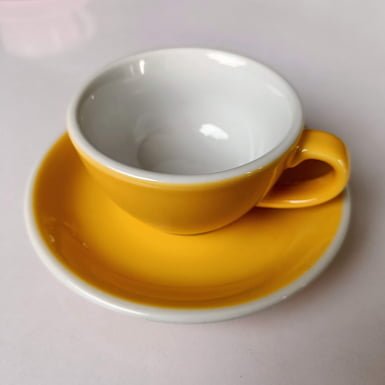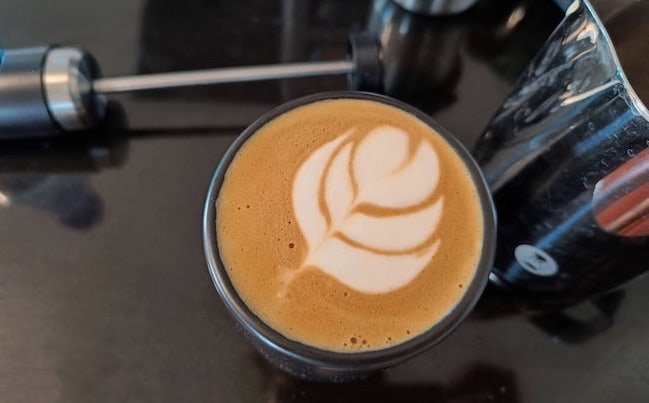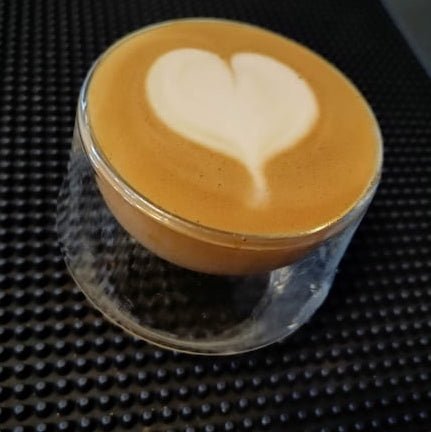Let’s be real: You can drink cappuccinos from all types of cups.
Pull an espresso shot, and add some steamed milk. Done.
If you’re skilled enough (I’m not…🤷♂️), you can even pour latte art into any cup, vessel, or container you may like.
But focusing on the finer details can make a noteworthy difference in many aspects of life.
When it comes to coffee, where personal preferences reign supreme, the visual appeal and tactile experience should not be underestimated.
With that in mind, allow me to introduce some of the nicest cups I have tested for milk-based coffee, and here we’re especially focusing on the ones that are also suitable for pouring those beautiful tulips, hearts, and unicorns.

The top Cups for Cappuccino & latte art
Choosing the right cups can make a noticeable difference if you want to elevate your lattes and cappuccinos to a new level. The proper cups not only enhance the visual appeal of your beverages, but they also make it easier for you to lay your base when you’re pouring latte art and will let the spout of the milk pitcher get only a few millimeters away from the surface.
They should, of course, also be pleasant to drink from. To save your time, I have listed the cups in order of preference.
1: Coffeezone Barista Speciality Coffee Cup

The Coffeezone coffee cup and saucer bring a classic, down-to-earth vibe to the world of coffee cups.
While the set may not be as fancy and famous as the competitors, it’s more affordable than the branded alternatives from Loveramics and ACME.
The cup has a simple yet solid design in various colors and sizes.
The hefty, premium feel is a pleasant surprise, considering its affordability. I must admit, I really enjoy drinking both black coffee and milky drinks from the pink version.
The 250 ml version is versatile, accommodating regular black coffee and larger lattes and cappuccinos. Smaller sizes are also available for cappuccinos and cortados.
Overall, this classic coffee cup is easy to recommend for those who appreciate a more traditional approach to coffee drinking.
See more reviews2: Kruve Imagine Latte Art Glass
The Kruve Imagine Milk Glass is specifically designed for latte art and milk drinks.
Initially, it might seem a bit over the top. However, after experiencing the awesomeness of Kruve’s Propel Espresso glasses, I decided to give these a try.
The Imagine glass has a unique design that blends the aesthetics of a bowl and a glass, which may initially feel odd in hand.
However, the surprisingly robust double-wall design (again similar to the Propel espresso cup) quickly becomes appreciated as it prevents the coffee from cooling down too quickly.
The glass is not only functional but also visually appealing. The double-walled design enhances the appearance of the coffee and latte art, while the unique shape of the glass makes pouring latte art a bit easier (it’s still not an easy task, though!)
Despite being somewhat fragile, the aesthetic appeal of these glasses is undeniable. They are a luxury purchase, ideally suited for those with a top-end espresso setup seeking to get the most out of their coffee hobby.
In conclusion, the Kruve Imagine Milk Glass offers a unique and visually pleasing experience for latte art enthusiasts, though its fragility may deter some. This stylish glass is worth considering if you want to invest in your coffee hobby.
Kruve Store3: Fellow Monty Cappuccino Latte Art Mug

The Fellow Monty Latte Art Cups have a sleek, modern design, which is typical of the brand.
They feel smooth in the hand and ooze of quality.
The cups come in various sizes, making them suitable for smaller milk-based drinks and americanos.
The curved bottom facilitates better latte art pouring, although some, including myself, may find the opening of the Cortado version, which I have, a bit too narrow for pouring milk patterns.
Go for the dedicated cappuccino/6.5 oz version if you want a larger opening.
The double-walled ceramic construction keeps the outside cool, and the base made out of a different material is an interesting touch.
Regarding aesthetics, the Monty cups are available in black and white and several different sizes.
The white option is particularly appealing for milk-based drinks.
These cups are a nice modern take on the cappuccino cup, albeit somewhat pricey.
Fellow Store4: Loveramics Egg Set Cup and Saucer

The Loveramics Egg Set Cup and Saucer feel premium and have a heavy ceramic construction.
The shape, while designed for cappuccino, flat white, and latte, is also suitable for regular coffee sipping.
This brand is used in many coffee shops worldwide, which speaks to its durability and functionality. The ergonomic handle and egg shape provide balance in hand, while the saucers included give it a classic European cafe style. Available in various colors, I tried the yellow one, which was quite pleasing to the eye.
However, I couldn’t help but notice that these cups are a bit more expensive than similar options from brands like Coffee Zone. It’s difficult to tell the difference between the two, and while there may be slightly more finesse in the Loveramics finish, I’m honestly not sure if it justifies the higher price.
In conclusion, the Loveramics Egg Cup is a stylish, functional, and durable option that is unlikely to go out of style.
However, the price tag may be a sticking point for some, as it’s not entirely clear if the additional cost is warranted compared to the options from more generic brands such as Coffeetime.
See more reviewsLatte Cups & Mugs Sizes
There are no hard and fast rules regarding latte cups and mugs sizes, as all milk drinks overlap to some degree. However, here’s a general guide for reference:
- Espresso: 2 – 3 oz (60 – 90 mL)
- Cortado: 3 – 4 oz (90 – 120 mL)
- Flat White: 4 – 5 oz (120 – 150 mL)
- Cappuccino: 5 – 6 oz (150 – 180 mL)
- Latte: 10 oz (300 mL)
- Grande from Starbucks: 16 oz (475 ml)
How to Choose the Perfect Latte Art Cups?
- Practice Makes Perfect: To create beautiful latte art, the key is practice. However, the shape and size of the cup can significantly impact your ability to pour impressive designs. To make the process easier, it’s essential to choose the right cup for your latte art.
- Short and Wide Cups: Short cups with a large diameter offer easier access to the liquid surface while leaving enough room for pouring art. These cups are perfect for beginners, as they provide a more forgiving space for learning the art of latte pouring.
- Bowl-Shaped Cups: Bowls or cup-shapes resembling bowls, like the Kruve Imagine series, are ideal for easier latte art pouring. The lack of edges or corners in these cups allows the espresso to distribute better and level when tilting, making it easier to create intricate designs.
- Regular Mugs? While regular mugs can be used for latte art, they may be more challenging due to their taller and narrower shape. Seasoned baristas can pour art in tall cups with practice, but starting with short cups is generally easier.
Materials for Latte Cups
Ceramic or porcelain is the classic option for latte cups. However, it’s a good idea to preheat these cups on top of an espresso machine to maintain the drink’s temperature.
Glass cups are becoming increasingly popular for lattes, with small Duralex-type glasses used for Gibraltars and larger ones for lattes.
Double-walled glasses like the Kruve Imagine series are also gaining popularity. These cups protect your fingers from heat while maintaining your drink’s warmth. Plus, they look great and showcase your latte art beautifully.

The Classic Cappuccino today
Developing in Italy during the early 20th century, the cappuccino has become a staple in coffee shops worldwide. This espresso-based beverage traditionally consists of an espresso shot, steamed milk, and milk foam; all served in a small cup in somewhat equal proportions. The secret to a classic cappuccino lies in the delicate balance between the bold espresso with its inviting crema and the creamy milk, topped with an inviting foam layer, often dusted with cocoa powder.
As specialty coffee culture gained popularity, the cappuccino underwent a significant transformation. This evolution focused on high-quality coffee beans, precise brewing techniques, and stunning latte art presentations. Key changes during this time included:
- The Bean Revolution: Baristas started using freshly roasted beans, often opting for single-origin or blends with unique flavor profiles to showcase coffee’s true potential.
- Steaming to Perfection: Improved milk steaming techniques resulted in velvety microfoam (tiny bubbles creating a rich, creamy texture) that perfectly complemented the espresso.
- The Art of Presentation: Latte art became an integral part of the cappuccino experience, with skillful baristas crafting visually appealing designs atop the foam.
- Dairy-Free Delights: Alternative milk options, such as soy, almond, or oat milk, were introduced to accommodate dietary needs and preferences.
These innovations solidified the cappuccino’s place in specialty coffee shops worldwide, offering a premium experience with each sip.
FAQ
-
What’s the difference between a cappuccino and a latte cup?
The difference lies in the cup size and the amount of foam. A cappuccino is typically served in a smaller cup, ranging from 5 to 6 ounces, while a latte is served in a larger cup, typically 11 to 15 ounces. Additionally, a cappuccino has a higher proportion of foam compared to a latte.
-
What is the coffee-to-milk ratio for a cappuccino?
A traditional cappuccino follows a 1:1:1 ratio, which means it contains equal parts of espresso, steamed milk, and milk foam. This ratio ensures a balanced flavor profile and a creamy texture.
-
How many shots of espresso are in a cappuccino?
A standard cappuccino typically consists of a double shot of espresso, which is around 2 ounces. However, it can vary based on personal preference or the specific coffee shop.
-
How to pour latte art in a regular cup?
To pour latte art in a regular cup, follow these steps:
- Start by pulling a shot or shots of espresso into your regular cup.
- Steam milk until it reaches a smooth, velvety texture.
- Hold the cup at a slight angle and pour the steamed milk slowly into the center of the espresso shot(s).
- As the cup fills, raise the pitcher slightly and create patterns by moving the pitcher side to side.
- For basic designs like a heart or a rosetta, practice the pouring motion while gradually increasing your speed.

